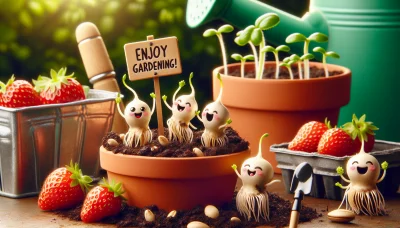Growing english cucumbers Quiz
Test Your Knowledge
Question of
Growing English Cucumbers: A Comprehensive Guide
Embarking on the journey of growing English cucumbers in your garden opens up a world of benefits, not only enhancing the diversity of your green space but also providing you with a fresh, flavorful addition to your culinary creations. These elongated, seedless varieties, known for their thin skin and sweet taste, are a gardener's delight. Adding them to your garden not only promises a bountiful harvest but also introduces an element of elegance to your vegetable patch. This guide aims to equip you with all the necessary information to successfully grow, care for, and harvest English cucumbers, ensuring a rewarding gardening experience.
Choosing the Right Variety
When it comes to gardening, selecting the right variety of English cucumbers can significantly impact your garden's productivity and enjoyment. English cucumbers, known for their long, slender shape and mild, sweet flavor, come in several varieties, each with unique characteristics. For instance, the 'Telegraph Improved' is highly prized for its exceptionally long, seedless fruits and resistance to common cucumber diseases, making it an excellent choice for those looking for ease of care and high yield. On the other hand, the 'Socrates' variety thrives in cooler climates and can even be grown in greenhouses during the winter, offering gardeners flexibility in planting schedules. For those interested in organic gardening, the 'Marketmore 76' is a popular choice due to its resistance to powdery mildew and cucumber mosaic virus, ensuring a healthy crop without the need for chemical interventions. When selecting the best variety for your garden, consider factors such as your local climate, the space available in your garden, and whether you prefer to grow your cucumbers outdoors or in a greenhouse. By understanding the unique characteristics of each variety, you can choose the best English cucumber that aligns with your gardening goals and enjoy a bountiful harvest.
Planting and Care Instructions
- Start by choosing a sunny location as English cucumbers require plenty of sunlight to thrive.
- Prepare the soil by ensuring it is well-draining and rich in organic matter. You can improve soil quality by mixing in compost or aged manure.
- Ensure the soil temperature is at least 60°F (15°C) before planting, as English cucumbers are sensitive to cold.
- Plant the cucumber seeds or seedlings about ½ to 1 inch deep into the soil.
- Space the plants about 18 to 36 inches apart in rows, allowing enough room for growth and air circulation.
- Water the plants thoroughly at the time of planting. Going forward, maintain consistent moisture by watering deeply once a week, or more frequently during hot, dry periods.
- Consider using mulch around the plants to help retain soil moisture and control weeds.
- Provide support for the plants, such as a trellis, to encourage vertical growth and healthy air circulation around the foliage.
- Monitor for pests and diseases regularly, and take action promptly to mitigate any issues.
- Harvest the cucumbers when they are about 6 to 8 inches long for the best flavor and texture. Regular harvesting encourages further fruit production.
Pest and Disease Management
English cucumbers, known for their thin skin and minimal seeds, are susceptible to various pests and diseases that can significantly impact their growth and yield. Common pests include spider mites, aphids, and cucumber beetles. Spider mites can cause the leaves to yellow and die, aphids suck sap and transmit diseases, and cucumber beetles can damage leaves and transmit bacterial wilt. To manage these pests, it's essential to monitor plants regularly, use insecticidal soaps or oils, and employ physical barriers like row covers. Diseases such as powdery mildew, downy mildew, and fusarium wilt also pose threats. Powdery mildew presents as white powdery spots on leaves, downy mildew causes yellow spots and leaf decay, and fusarium wilt affects the vascular system of the plant, leading to wilted and yellow leaves. Effective disease management includes using disease-resistant cucumber varieties, ensuring proper spacing for air circulation, and practicing crop rotation to prevent soil-borne diseases. Additionally, applying fungicides as preventive measures can be beneficial. By adopting an integrated pest and disease management approach, gardeners can protect their English cucumbers and enjoy a bountiful harvest.
Harvesting and Storage Tips
- Harvest English cucumbers when they are at their peak size but before they start to turn yellow. This is typically when they are about 10 to 12 inches long and still firm.
- Use a sharp knife or garden clippers to cut the cucumber from the vine. Be careful not to damage the vine or nearby cucumbers.
- Harvest cucumbers early in the morning when temperatures are cooler. This helps to ensure they are crisp and more hydrated.
- After harvesting, wash the cucumbers gently in cool water to remove any dirt or pesticides. Pat them dry with a clean cloth or paper towel.
- Store cucumbers in the refrigerator to keep them fresh. Place them in the crisper drawer if possible, as this helps maintain the right humidity level.
- To prevent cucumbers from drying out, wrap them in a moist paper towel and then place them in a plastic bag before refrigerating. Make sure the bag is not completely sealed to allow for some air circulation.
- Avoid storing cucumbers near fruits that produce ethylene gas, like tomatoes, bananas, and melons, as this can cause them to spoil faster.
- For longer-term storage, cucumbers can be pickled. This not only extends their shelf life but also offers a variety of flavors depending on the pickling solution used.
Frequently Asked Questions
| Question | Answer |
|---|---|
| What is the best fertilizer for English cucumbers? | Use a balanced, water-soluble fertilizer with equal parts nitrogen, phosphorus, and potassium (N-P-K). Apply every two weeks once the plants start flowering and producing fruits. |
| How often should I water my English cucumbers? | Water deeply once a week, providing about 1 to 2 inches of water. Adjust based on rainfall and check the soil moisture to avoid over-watering. |
| What are some good companion plants for English cucumbers? | Marigolds, peas, radishes, and beans are excellent companions. They can help deter pests and improve growth conditions. |
| How can I prevent cucumber beetles? | Use row covers to protect the plants, especially during early growth. Remove the covers when flowering begins to allow for pollination. |
| Why are my cucumber leaves turning yellow? | Yellowing leaves can be a sign of over-watering, nutrient deficiency, or disease. Check soil moisture, ensure proper fertilization, and look for signs of disease or pests. |
| Can English cucumbers be grown vertically? | Yes, growing them vertically on trellises or supports can save space, improve air circulation, and make harvesting easier. |
| What is the ideal soil pH for growing English cucumbers? | The ideal soil pH is between 6.0 and 6.8 for optimal nutrient uptake and growth. |












